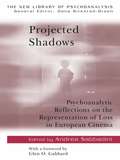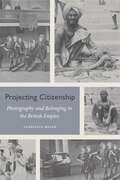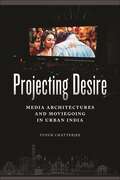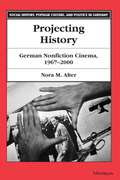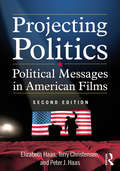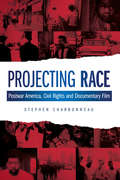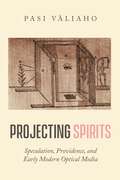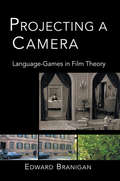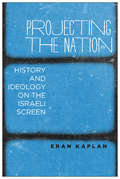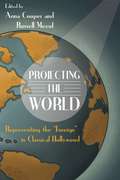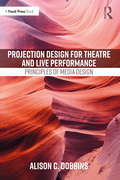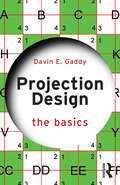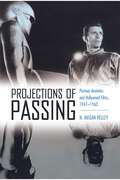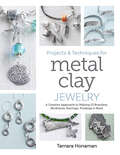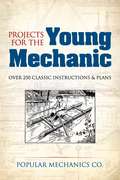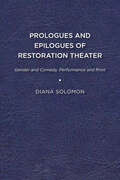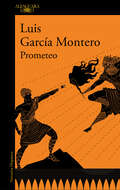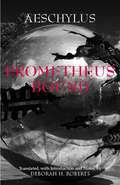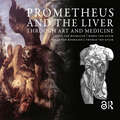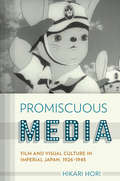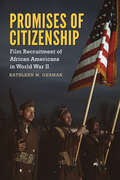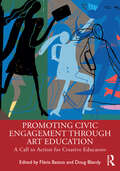- Table View
- List View
Projected Shadows: Psychoanalytic Reflections on the Representation of Loss in European Cinema (The New Library of Psychoanalysis)
by Andrea SabbadiniProjected Shadows presents a new collection of essays exploring films from a psychoanalytic perspective, focusing specifically on the representation of loss in European cinema. This theme is discussed in its many aspects, including: loss of hope and innocence, of youth, of consciousness, of freedom and loss through death. Many other themes familiar to psychoanalytic discourse are explored in the process, such as: Establishment and resolution of Oedipal conflicts Representation of pathological characters on the screen Use of unconscious defence mechanisms The interplay of dreams, reality and fantasy Projected Shadows aims to deepen the ongoing constructive dialogue between psychoanalysis and film. Andrea Sabbadini has assembled a remarkable number of internationally renowned contributors, both academic film scholars and psychoanalysts from a variety of cultural backgrounds, who use an array of contemporary methodologies to apply psychoanalytic thinking to film. This original collection will appeal to anyone passionate about film, as well as professionals, academics and students interested in the relationship between psychoanalysis and the arts.
Projecting Citizenship: Photography and Belonging in the British Empire
by Gabrielle MoserIn Projecting Citizenship, Gabrielle Moser gives a comprehensive account of an unusual project produced by the British government’s Colonial Office Visual Instruction Committee at the beginning of the twentieth century—a series of lantern slide lectures that combined geography education and photography to teach schoolchildren around the world what it meant to look and to feel like an imperial citizen.Through detailed archival research and close readings, Moser elucidates the impact of this vast collection of photographs documenting the land and peoples of the British Empire, circulated between 1902 and 1945 in classrooms from Canada to Hong Kong, from the West Indies to Australia. Moser argues that these photographs played a central role in the invention and representation of imperial citizenship. She shows how citizenship became a photographable and teachable subject by tracing the intended readings of the images that the committee hoped to impart to viewers and analyzing how spectators may have used their encounters with these photographs for protest and resistance. Interweaving political and economic history, history of pedagogy, and theories of citizenship with a consideration of the aesthetic and affective dimensions of viewing the lectures, Projecting Citizenship offers important insights into the social inequalities and visual language of colonial rule.
Projecting Citizenship: Photography and Belonging in the British Empire
by Gabrielle MoserIn Projecting Citizenship, Gabrielle Moser gives a comprehensive account of an unusual project produced by the British government’s Colonial Office Visual Instruction Committee at the beginning of the twentieth century—a series of lantern slide lectures that combined geography education and photography to teach schoolchildren around the world what it meant to look and to feel like an imperial citizen.Through detailed archival research and close readings, Moser elucidates the impact of this vast collection of photographs documenting the land and peoples of the British Empire, circulated between 1902 and 1945 in classrooms from Canada to Hong Kong, from the West Indies to Australia. Moser argues that these photographs played a central role in the invention and representation of imperial citizenship. She shows how citizenship became a photographable and teachable subject by tracing the intended readings of the images that the committee hoped to impart to viewers and analyzing how spectators may have used their encounters with these photographs for protest and resistance. Interweaving political and economic history, history of pedagogy, and theories of citizenship with a consideration of the aesthetic and affective dimensions of viewing the lectures, Projecting Citizenship offers important insights into the social inequalities and visual language of colonial rule.
Projecting Desire: Media Architectures and Moviegoing in Urban India (Critical Cultural Communication)
by Tupur ChatterjeeHow middle-class women transformed India’s screen and exhibition industriesSince the late 90s, multiplexes in India have almost always been located inside malls, rendering it impossible to inhabit one space without also inhabiting the other. Their prevalence coincides with a shift in the spectatorial imagination of India’s mass audience—spaces that, for several preceding decades, had been designed for the subaltern male, but are now built for the consuming, globalized middle-class woman. By catering to the mutable desires and anxieties of a rapidly expanding and heterogeneous middle class, the mall-multiplex has radically altered the politics of theatrical space and moviegoing. Projecting Desire tells the story of this moment of historic transition as it played out across media industries, architecture and design, popular cinema, and public culture. Tupur Chatterjee highlights how the multiplex established a new link between media and architecture in the subcontinent, not only rewriting the relation between gender and urban space, but also changing the shapes of Indian cities. Projecting Desire locates the post-globalization transformation of India’s screen and exhibition industries in a longer arc of ideas about urban planning and architecture, long mired in caste- and class-based gendered anxieties. It argues that the architectural mediations of India’s moviegoing cultures are key to imagining, planning, and policing the contemporary media city. Chatterjee integrates industrial and organizational ethnography, in-depth interviews, participant observation, discourse and textual analysis, and archival work with spatial and urban histories. Focusing on these new meccas of leisure and entertainment, Projecting Desire tracks the understudied nexus between new media architectures, cultures of public leisure, and popular cinema in the Global South.
Projecting History
by Nora M. AlterThe intersection between social, historical, and political developments in Germany and the emergence of a nonfiction mode of film production
Projecting Politics: Political Messages in American Films
by Terry Christensen Peter J. Haas Elizabeth HaasThe new edition of this influential work updates and expands the scope of the original, including more sustained analyses of individual films, from The Birth of a Nation to The Wolf of Wall Street. An interdisciplinary exploration of the relationship between American politics and popular films of all kinds—including comedy, science fiction, melodrama, and action-adventure—Projecting Politics offers original approaches to determining the political contours of films, and to connecting cinematic language to political messaging. A new chapter covering 2000 to 2013 updates the decade-by-decade look at the Washington-Hollywood nexus, with special areas of focus including the post-9/11 increase in political films, the rise of political war films, and films about the 2008 economic recession. The new edition also considers recent developments such as the Citizens United Supreme Court decision, the controversy sparked by the film Zero Dark Thirty, newer generation actor-activists, and the effects of shifting industrial financing structures on political content. A new chapter addresses the resurgence of the disaster-apocalyptic film genre with particular attention paid to its themes of political nostalgia and the turn to global settings and audiences. Updated and expanded chapters on nonfiction film and advocacy documentaries, the politics of race and African-American film, and women and gender in political films round out this expansive, timely new work. A companion website offers two additional appendices and further materials for those using the book in class.
Projecting Race: Postwar America, Civil Rights, and Documentary Film (Nonfictions)
by Stephen CharbonneauProjecting Race presents a history of educational documentary filmmaking in the postwar era in light of race relations and the fight for civil rights. Drawing on extensive archival research and textual analyses, the volume tracks the evolution of race-based, nontheatrical cinema from its neorealist roots to its incorporation of new documentary techniques intent on recording reality in real time. The films featured include classic documentaries, such as Sidney Meyers's The Quiet One (1948), and a range of familiar and less familiar state-sponsored educational documentaries from George Stoney (Palmour Street, 1950; All My Babies, 1953; and The Man in the Middle, 1966) and the Drew Associates (Another Way, 1967). Final chapters highlight community-development films jointly produced by the National Film Board of Canada and the Office of Economic Opportunity (The Farmersville Project, 1968; The Hartford Project, 1969) in rural and industrial settings. Featuring testimonies from farm workers, activists, and government officials, the films reflect communities in crisis, where organized and politically active racial minorities upended the status quo. Ultimately, this work traces the postwar contours of a liberal racial outlook as government agencies came to grips with profound and inescapable social change.
Projecting Spirits: Speculation, Providence, and Early Modern Optical Media
by Pasi VäliahoThe history of projected images at the turn of the seventeenth century reveals a changing perception of chance and order, contingency and form. In Projecting Spirits, Pasi Väliaho maps how the leading optical media of the period—the camera obscura and the magic lantern—developed in response to, and framed, the era's key intellectual dilemma of whether the world fell under God's providential care, or was subject to chance and open to speculating. As Väliaho shows, camera obscuras and magic lanterns were variously employed to give the world an intelligible and manageable design. Jesuit scholars embraced devices of projection as part of their pursuit of divine government, whilst the Royal Society fellows enlisted them in their quest for empirical knowledge as well as colonial expansion. Projections of light and shadow grew into critical metaphors in early responses to the turbulences of finance. In such instances, Väliaho argues, "projection" became an indispensable cognitive form to both assert providence, and to make sense of an economic reality that was gradually escaping from divine guidance. Drawing on a range of materials—philosophical, scientific and religious literature, visual arts, correspondence, poems, pamphlets, and illustrations—this provocative and inventive work expands our concept of the early media of projection, revealing how they spoke to early modern thinkers, and shaped a new, speculative concept of the world.
Projecting a Camera: Language-Games in Film Theory
by Edward BraniganIn Projecting a Camera, film theorist Edward Branigan offers a groundbreaking approach to understanding film theory. Why, for example, does a camera move? What does a camera "know"? (And when does it know it?) What is the camera's relation to the subject during long static shots? What happens when the screen is blank? Through a wide-ranging engagement with Wittgenstein and theorists of film, he offers one of the most fully developed understandings of the ways in which the camera operates in film. With its thorough grounding in the philosophy of spectatorship and narrative, Projecting a Camera takes the study of film to a new level. With the care and precision that he brought to Narrative Comprehension and Film, Edward Branigan maps the ways in which we must understand the role of the camera, the meaning of the frame, the role of the spectator, and other key components of film-viewing. By analyzing how we think, discuss, and marvel about the films we see, Projecting a Camera, offers insights rich in implications for our understanding of film and film studies.
Projecting the Nation: History and Ideology on the Israeli Screen
by Eran KaplanProjecting the Nation: History and Ideology on the Israeli Screen is a wide-ranging history of over seven decades of Israeli cinema. The only book in English to offer this type of historical scope was Ella Shohat’s Israeli Cinema: East West and the Politics of Representation from 1989. Since 1989, however, Israeli cinema and Israeli society have undergone some crucial transformations and, moreover, Shohat’s book offered a single framework through which to judge Israeli cinema: a critique of orientalism. Projecting the Nation contends that Israeli cinema offers much richer historical and ideological perspectives that expose the complexity of the Israeli project. By analyzing Israeli films which address such issues as the Arab-Israeli conflict, the Ashkenazi-Mizrahi divide, the kibbutz and urban life, the rise of religion in Israeli public life and more, the book explores the way cinema has represented and also shaped our understanding of the history of modern Israel as it evolved from a collectivist society to a society where individualism and adherence to local identities is the dominant ideology.
Projecting the World: Representing the "Foreign" in Classical Hollywood
by Russell Meeuf Anna CooperThe classical Hollywood films that were released between the 1930s and 1960s were some of the most famous products of global trade, crisscrossing borders and rising to international dominance. In analyzing a series of Hollywood films that illustrate moments of nuanced transnational engagement with the “foreign,” Projecting the World: Representing the “Foreign” in Classical Hollywood enriches our understanding of mid-twentieth-century Hollywood cinema as a locus of imaginative geographies that explore the United States’ relationship with the world. While previous scholarship has asserted the imperialism and racism at the core of classical Hollywood cinema, Anna Cooper and Russell Meeuf’s collection delves into the intricacies—and sometimes disruptions—of this assumption, seeing Hollywood films as multivalent and contradictory cultural narratives about identity and politics in an increasingly interconnected world. Projecting the World illustrates how Hollywood films negotiate shifting historical contexts of internationalization through complex narratives about transnational exchange—a topic that has thus far been neglected in scholarship on classical Hollywood. The essays analyze the “foreign” with topics such as the 1930s island horror film, the 1950s Mexico-set bullfighting film, Hollywood’s projection of “exoticism” on Argentina, and John Wayne’s film sets in Africa. Against the backdrop of expanding consumer capitalism and the growth of U.S. global power, Hollywood films such as Tarzan and Anatahan, as well as musicals about Paris, offered resonant images and stories that dramatized America’s international relationships in complicated ways. A fascinating exploration of an oft-overlooked aspect of classical Hollywood films, Projecting the World offers a series of striking new analyses that will entice cinema lovers, film historians, and those interested in the history of American neocolonialism.
Projection Design for Theatre and Live Performance: Principles of Media Design
by Alison C. DobbinsProjection Design for Theatre and Live Performance explores the design and creation process of projections from a non-technical perspective, examining the principles of media for the stage in a manner that is accessible for both beginning designers and advanced designers dabbling in projections for the first time. This introductory text covers concepts and tools for designing, techniques to help readers tap into their creativity, and the core skills required of this field: problem solving, project management, and effective communication. Focusing exclusively on design and creativity, this book encourages individuals to leap into the creative design process before facing any perceived hurdles of learning everything technical about media delivery systems, cueing systems, projectors, cables, computer graphics, animation, and video production. Projection Design for Theatre and Live Performance is a reminder that, from the invention of photography to the enormous variety of electronic media that exist today, the ways projection designers can enhance a theatrical production are limitless. Written in an accessible style, this book is a valuable resource for students of Projection Design as well as emerging professionals. Its focus on design and creativity will restore the confidence of individuals who may have been daunted by technical hurdles and will encourage the creativity of those who may have been disappointed with their efforts in this field of design in the past.
Projection Design: The Basics (The Basics)
by Davin E. GaddyProjection Design: The Basics explores the concepts of visual elements in live entertainment. It provides a conversational view of the fundamentals of projection design, from production meetings and the elements of visual design to the equipment necessary to make it all happen.This text examines the themes and theories universal to a wide range of topics, to provide a foundation for anyone interested in using video for their live production or those who are looking where to start as a designer. Topics covered include: Methods of extracting visuals from a script and communicating them to production staff Basics of visual design Understanding human perception and how this influences design How to choose the right equipment to build a system With a detailed glossary, basic formulas, and comprehensive explanation from start to finish, Projection Design: The Basics is an ideal primer for Projection Design courses, and will be of interest to anyone entering the field of projection and media design for the first time.
Projections of Passing: Postwar Anxieties and Hollywood Films, 1947-1960
by N. Megan KelleyA key concern in postwar America was “who's passing for whom?” Analyzing representations of passing in Hollywood films reveals changing cultural ideas about authenticity and identity in a country reeling from a hot war and moving towards a cold one. After World War II, passing became an important theme in Hollywood movies, one that lasted throughout the long 1950s, as it became a metaphor to express postwar anxiety. The potent, imagined fear of passing linked the language and anxieties of identity to other postwar concerns, including cultural obsessions about threats from within. Passing created an epistemological conundrum that threatened to destabilize all forms of identity, not just the longstanding American color line separating white and black. In the imaginative fears of postwar America, identity was under siege on all fronts. Not only were there blacks passing as whites, but women were passing as men, gays passing as straight, communists passing as good Americans, Jews passing as gentiles, and even aliens passing as humans (and vice versa). Fears about communist infiltration, invasion by aliens, collapsing gender and sexual categories, racial ambiguity, and miscegenation made their way into films that featured narratives about passing. N. Megan Kelley shows that these films transcend genre, discussing Gentleman's Agreement, Home of the Brave, Pinky, Island in the Sun, My Son John, Invasion of the Body-Snatchers, I Married a Monster from Outer Space, Rebel without a Cause, Vertigo, All about Eve, and Johnny Guitar, among others. Representations of passing enabled Americans to express anxieties about who they were and who they imagined their neighbors to be. By showing how pervasive the anxiety about passing was, and how it extended to virtually every facet of identity, Projections of Passing broadens the literature on passing in a fundamental way. It also opens up important counter-narratives about postwar America and how the language of identity developed in this critical period of American history.
Projects and Techniques for Metal Clay Jewelry: A Creative Approach to Making 13 Bracelets, Necklaces, Earrings, Findings and More
by Tamara HonamanMetal Clay has been on the scene since the early 1990s but is still considered a new medium in the jewelry universe. While there are books, videos, and content on the market, there is room for more to be shared, especially with all the changes that have occurred in metal clay in the last decade+. The changes, developments, and expansions in the metal clays available on the market (base metal clays as well as other variants of silver), has also broadened the appeal of metal clay. Those who were originally not interested (primarily traditional metalsmiths) are appreciating the staying power of the material and exploring the benefits the clay can offer to their work. And those new to the field are embracing metal clay as it allows the person to create metal designs without the need for expensive metalsmithing tools. Finished metal clay attracts the eye as you&’re able to create designs with intricate details, fine texture, and you can achieve a high-polish finish. As soon as people realize they too can create beautiful designs from clay, they are drawn in! There really is nothing like working with &“clay&” and having it be transformed to metal through the simple application of heat. Having been part of the metal clay community since the late 90s, seeing first-hand the joy people have working with the material, helping them overcome their trepidations, convincing those hesitant to give a try, pushing the boundaries of the materials available, and translating that into teachable programs is what I bring to the table. My passion drives me to continue learning and sharing so others can be empowered to create.
Projects for the Young Mechanic: Over 250 Classic Instructions & Plans (Dover Children's Activity Books)
by Popular Mechanics Co.From creating artificial pearls to building a steam boiler, these vintage projects for indoors and outdoors offer a tremendous range of possibilities. Over 250 classic plans and instructions explain how to make model airplanes, greeting cards, a motion-picture camera, a radiophone, a cipher code, motor-driven sleds, and other projects. Drawn from the best of Popular Mechanics magazines from the 1910s and '20s, they combine the excitement and satisfaction of building and creating with the lasting value of learning the practical applications of scientific principles.The step-by-step instructions are accompanied by charming drawings and photos that clearly illustrate each project. Girls and boys will be captivated by these antique instructions and plans, and adults will appreciate the projects' nostalgic appeal.
Projects to Get You Off the Grid: Rain Barrels, Chicken Coops, and Solar Panels
by Instructables. Com Noah WeinsteinInstructables is back with this compact book focused on a series of projects designed to get you thinking creatively about thinking green.<P><P> Twenty Instructables illustrate just how simple it can be to make your own backyard chicken coop, or turn a wine barrel into a rainwater collector.Illustrated with dozens of full-color photographs per project accompanying easy-to-follow instructions, this Instructables collection utilizes the best that the online community has to offer, turning a far-reaching group of people into a mammoth database churning out ideas to make life better, easier, and in this case, greener, as this volume exemplifies.
Prologues and Epilogues of Restoration Theater: Gender and Comedy, Performance and Print
by Diana SolomonOften perceived as merely formulaic or historical documents, dramatic prologues and epilogues – players’ comic, poetic bids for the audience’s good opinion – became essential parts of Restoration theater, appearing in over 90 percent of performed and printed plays between 1660 and 1714. Their popularity coincided with the rise of the English actress, and Prologues and Epilogues of Restoration Theater unites these elements in the first book-length study on the subject. It finds that these paratexts provided the first sanctioned space for actresses in Britain to voice ideas in public, communicate directly with other women, and perform comedy – arguably the most powerful type of speech, and one that enabled interrogation of misogynist social practices. This book provides a taxonomy of prologues and epilogues with a corresponding appendix, and demonstrates through case studies of Anne Bracegirdle and Anne Oldfield how the study of prologues and epilogues enriches Restoration theater scholarship. Published by University of Delaware Press. Distributed worldwide by Rutgers University Press.
Prometeo
by Luis García MonteroEL NUEVO LIBRO DE LUIS GARCÍA MONTERO UN MITO CON PLENA VIGENCIA, EL DEL DESAFÍO A LOS DIOSES.UN CANTO DE ESPERANZA EN EL SER HUMANO. «Es uno de los pocos destinados a la letra grande de la historia de la literatura».José-Carlos Mainer «Admiro mucho su capacidad de seguir batallando, de no rendirse en la lucha por cambiar las cosas sin haber caído en la rabia, el resentimiento, la frustración».Juan Diego Botto «Se acercó hasta la hoguera, sostuvo la mirada contra el fuego y afirmó lentamente, una vez más: esperemos aún, sigamos todavía». Vivimos tiempos, como afirma Luis García Montero en este libro, en los que la conciencia del presente nos devuelve a la historia del pasado para fortalecernos en el deseo de resistencia. Y es éste el motivo que ha llevado al autor, a lo largo de los últimos años, a reflexionar desde el ensayo, la poesía y el teatro sobre la actualidad política y social del mito de Prometeo, ese titán que osó enfrentarse a los dioses y les robó el fuego para entregárselo a los mortales y regalarles con él la libertad. Esta obra reúne los textos de García Montero centrados en la figura rebelde de Prometeo. La pieza central —llevada a la escena por José Carlos Plaza en 2019 en el Festival de Teatro Clásico de Mérida— propone un diálogo intergeneracional entre dos Prometeos: el joven, que duda del acierto de su rebelión dado el castigo que trajo consigo, y el anciano, que desde su experiencia le muestra el triunfo que conlleva siempre buscar el bien común. En definitiva, Prometeo es un canto esperanzador sobre la humanidad, una lúcida reflexión en torno al poder de la solidaridad, la justicia y la libertad. Aquí, el mito, transformado a la luz de esta existencia convulsa e hiperconectada en la que estamos inmersos, sigue alentándonos hoy a sentarnos juntos alrededor del fuego para contarnos nuestro propio pasado y discutir sobre el futuro que merecemos. La crítica ha dicho:«Es uno de los pocos destinados a la letra grande de la historia de la literatura».José-Carlos Mainer «Parece capaz de contarnos, y de qué manera, lo que habíamos olvidado que sabíamos de nosotros mismos».Joaquín Sabina «Tono sostenido, poderosa nostalgia, emoción delicada que no alza la voz, poesía escueta, ceñida...».Octavio Paz «Admiro mucho su capacidad de seguir batallando, de no rendirse en la lucha por cambiar las cosas sin haber caído en la rabia, el resentimiento, la frustración».Juan Diego Botto «El mayor referente poético de España, cabeza de generación».Carmen Rengel, El HuffPost «García Montero ha defendido unos objetivos de invariable lucidez y ha logrado que su poesía remita con rigor minucioso a sus ideas estéticas. Y eso lo ha aproximado a lo que suele identificarse con un joven maestro».José Manuel Caballero Bonald «Siempre ha optado por ser testigo de su tiempo y su poesía ha sido el reflejo de sus inquietudes».Carmen Sigüenza, Agencia EFE
Prometheus Bound
by Aeschylus Deborah RobertsThis is an outstandingly useful edition of Prometheus Bound. The translation is both faithful and graceful, and the introduction to this difficult play is a model of clarity, intelligence, and a profound familiarity with the workings of Greek myth, Greek literature, and literature in general. --Rachel Hadas, Department of English, Rutgers University
Prometheus and the Liver through Art and Medicine
by Julia Rosmalen Merel Gulik Belle Rosmalen Thomas GulikPrometheus was punished by the supreme god Zeus for giving to mankind the Olympic fire with which they learned to think and feel. He was chained to a cliff in the Caucasus, where, to make matters worse, he was visited daily by an eagle who ate part of his liver. At night, however, his liver grew back. We now know that the liver can regenerate, but were the ancient Greeks aware of this quality? The myth of Prometheus has been a source of inspiration for many visual artists over the centuries. In this book, the medical history of the liver is traced through the ages through an examination of historical texts on the organ’s functions and properties, parallel to the art movements in which the fascinating iconography of Prometheus is reviewed. The book offers a surprising interplay of art and medicine, placing emphasis on the unique morphology of the liver.
Promiscuous Grace: Imagining Beauty and Holiness with Saint Mary of Egypt (Class 200: New Studies in Religion)
by Sonia VelázquezA meditation on holiness and beauty through the study of Saint Mary of Egypt. Saint Mary of Egypt has fascinated theologians, poets, and artists since the seventh century. Her story is richly evocative, encompassing sin and sanctity, concupiscence and asceticism, youth and old age. In Promiscuous Grace, Sonia Velázquez thinks with Saint Mary of Egypt about the relationship between beauty and holiness. Drawing on an archive spanning Spanish medieval poetry, Baroque paintings, seventeenth-century hagiography, and Balzac’s Le chef-d’œuvre inconnu, Velázquez argues for the importance of the senses on the surface of religious texts on her way to revealing why the legend of Saint Mary of Egypt still matters today.
Promiscuous Media: Film and Visual Culture in Imperial Japan, 1926-1945 (Studies of the Weatherhead East Asian Institute, Columbia University)
by Hikari HoriIn Promiscuous Media, Hikari Hori makes a compelling case that the visual culture of Showa-era Japan articulated urgent issues of modernity rather than serving as a simple expression of nationalism. Hori makes clear that the Japanese cinema of the time was in fact almost wholly built on a foundation of Russian and British film theory as well as American film genres and techniques. Hori provides a range of examples that illustrate how maternal melodrama and animated features, akin to those popularized by Disney, were adopted wholesale by Japanese filmmakers.Emperor Hirohito's image, Hori argues, was inseparable from the development of mass media; he was the first emperor whose public appearances were covered by media ranging from postcards to radio broadcasts. Worship of the emperor through viewing his image, Hori shows, taught the Japanese people how to look at images and primed their enjoyment of early animation and documentary films alike. Promiscuous Media links the political and the cultural closely in a way that illuminates the nature of twentieth-century Japanese society.
Promises of Citizenship: Film Recruitment of African Americans in World War II (Race, Rhetoric, and Media Series)
by Kathleen GermanSince the earliest days of the nation, US citizenship has been linked to military service. Even though blacks fought and died in all American wars, their own freedom was usually restricted or denied. In many ways, World War II exposed this contradiction.As demand for manpower grew during the war, government officials and military leaders realized that the war could not be won without black support. To generate African American enthusiasm, the federal government turned to mass media. Several government films were produced and distributed, movies that have remained largely unexamined by scholars. Kathleen M. German delves into the dilemma of race and the federal government's attempts to appeal to black patriotism and pride even while postponing demands for equality and integration until victory was achieved.German's study intersects three disciplines: the history of the African American experience in World War II, the theory of documentary film, and the study of rhetoric. One of the main films of the war era, The Negro Soldier, fractured the long tradition of degrading minstrel caricatures by presenting a more dignified public image of African Americans. Along with other government films, the narrative within The Negro Soldier transformed the black volunteer into an able soldier. It included African Americans in the national mythology by retelling American history to recognize black participation. As German reveals, through this new narrative with more dignified images, The Negro Soldier and other films performed rhetorical work by advancing the agenda of black citizenship.
Promoting Civic Engagement Through Art Education: A Call to Action for Creative Educators
by Doug Blandy Flávia BastosThis textbook equips students and educators committed to understanding how art and creative practice work as powerful communicative tools and have a substantial role in advancing civic participation. Alongside promoting educational practices with learners’ civic engagement in mind, this book is a call to action, inviting creative educators to explore the potential of art for developing critical perspectives, articulating voices and diverse points of view, and engaging in dialogue across difference. Chapters assist students and educators in understanding critical concepts ranging from the protections afforded art under the constitution, to the role of civic institutions such as museums, community arts centers, and schools in advancing civic participation. They also present the relationship between art, education, and civic engagement using watershed political moments such as voter suppression initiatives, xenophobic reactions to the COVID-19 pandemic, and widespread national Black Lives Matter protests. Readers are guided throughout with a series of key questions at the onset of each chapter and encouraged to investigate further the issues discussed through exploration of the many resources embedded in each chapter. Coursework and participatory learning experiences that orient future and current art educators to the relationship of the arts and culture to democracy are also featured.This book will be ideal for students in art education in both upper division undergraduate and graduate levels, with cross-curricular appeal for students of political science, social studies, sociology, public history, public anthropology, heritage studies, and public humanities. As well as this, it will be a must read for educators who are asked to respond to challenges within the political sphere, and how these political challenges are influencing educational environments.
